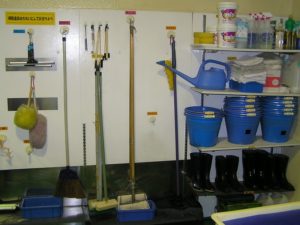5S is foundation for implementation of Lean Manufacturing / Kaizen / TPM etc. if Gemba is full of unwanted items, dust, dirt, no improvement is possible. Also poor housekeeping leads to lot of wasteful activities such as searching, waiting, excess motion and excess inventory. 5S is very powerful tool if understood and implemented in right way. 5S was made popular by Toyota and orginal Japanese names for 5s , are as follows:
1. Seiri (Sorting): Distinguish between necessary and unnecessary items in the gemba, and remove unwanted items from Gemba
2. Seiton (Systematic Arrangement): Arrange all items remaining after seiri in an orderly & systematic manner.
3. Seiso (Scrub or clean): Keep shop floor, machines and working environments clean.
4. Seiketsu (Standardise): Create standards to sustain and follow Seiri, Seiton and Seiso
5. Shitsuke (Sustain): Build self-discipline and make a habit of engaging in 5S by establishing standards.
Let us learn in detail about first 3S:
Seiri: “The first step of housekeeping, seiri, entails classifying items in the gemba into two categories—necessary and unnecessary—and discarding the unwanted items from the gemba. All sorts of objects can be found in the gemba. A close look reveals that only a small number of them are needed in daily work; many others either will never be used or will be needed only in the distant future. Generally gemba is full of unused machines, jigs, dies and tools, rejects, work-in-process, raw materials, supplies and parts, shelves, containers, desks, workbenches, files of documents, carts, racks, pallets, and other items. An easy rule of thumb is to remove anything that will not be used within the next 30 days. Red tag campaign is key strategy for implementing Seiri (Sorting). Red tags are attached to unwanted items so that such items can be seen visibly .
Seiton: Once seiri has been carried out, all unnecessary items have been removed from gemba, leaving only the minimum number needed, next step is to implement Seiton. Seiton means classifying items by use and arranging them accordingly to minimize search time and effort. To do this, each item must have a designated name, address, and volume. Not only the location but also the maximum number of items allowed in the gemba must be specified. For example, work-in-process cannot be produced in unlimited quantities. Instead, the floor space for the boxes containing the work must be delineated clearly (by painting a rectangle to mark off the area, etc.), and a maximum allowable number of boxes—say, five—must be designated.
Seiso: means cleaning the working environment, including machines and tools, as well as the floors, walls, and other areas of the workplace. There is also an axiom that goes, “Seiso is checking.” An operator cleaning a machine can find many malfunctions. When the machine is covered with oil, soot, and dust, it is difficult to identify any problems that may be developing. While cleaning the machine, however, one can easily spot oil leakage, a crack developing on the cover, or loose nuts and bolts. Once these problems are recognized, they are easily fixed.
the workplace. There is also an axiom that goes, “Seiso is checking.” An operator cleaning a machine can find many malfunctions. When the machine is covered with oil, soot, and dust, it is difficult to identify any problems that may be developing. While cleaning the machine, however, one can easily spot oil leakage, a crack developing on the cover, or loose nuts and bolts. Once these problems are recognized, they are easily fixed.
It is said that most machine breakdowns begin with vibration (owing to loose nuts and bolts), with the introduction of foreign particles such as dust (owing to a crack on the cover, for instance), or with inadequate oiling and greasing. For this reason, seiso is a great learning experience for operators because they can make many useful discoveries while cleaning machines. Seiso is also backbone of first step of Autonomous maintenance of TPM.

